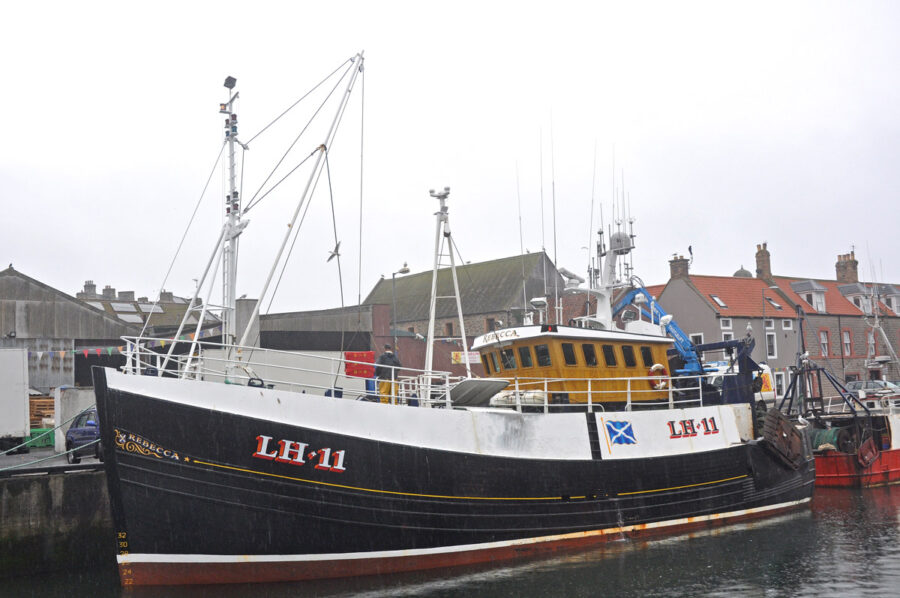David Linkie looks back to a night aboard Eyemouth skipper Alan Blackie’s twin-rig prawn trawler Rebecca LH 11 in August 2014
Although the dusk to dawn summer Nephrops fishery in southeast Scotland no longer attracts the number of boats it did 20 years ago, due to the diminishing number of vessels, it has long been of vital importance to the mixed fleet of local prawn trawlers that fish from Eyemouth, Dunbar, Port Seton and Pittenweem.
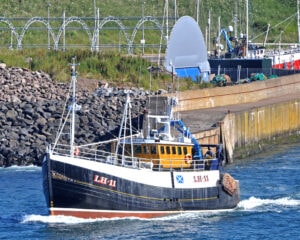
01. Rebecca leaving Eyemouth harbour to fish prawns overnight in the Firth of Forth.
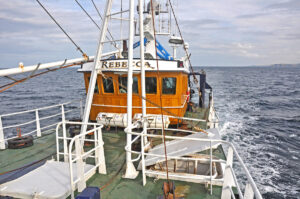
02. St Abbs headland is left astern as Rebecca heads towards May Island.
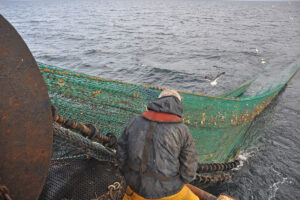
03. Shooting the twin-rig gear away…
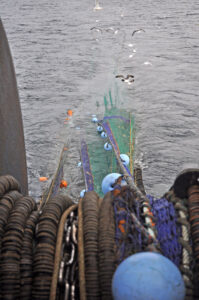
04. … off the elevated net drum.
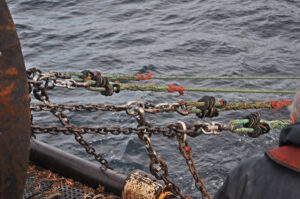
05. Preparing to release the combination sweeps.
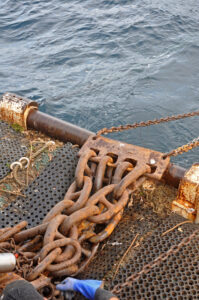
06. The 750kg chain clump ready to go over the transom.
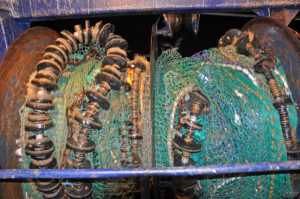
07. Hauling underway as the ground gear starts to be taken onto the net drum.
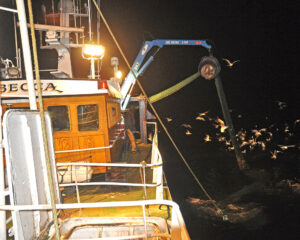
08. Using the block to swing the port net round…
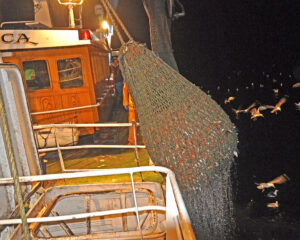
09. … before taking a three-quarter lift of clean prawns aboard.
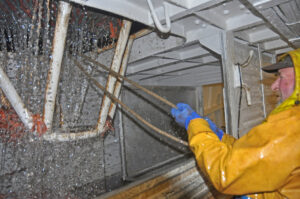
10. Untying the codline…
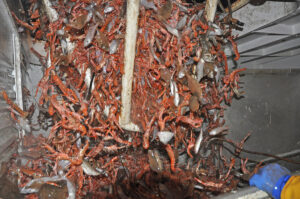
11. … and releasing a good lift of clean prawns from the starboard codend.
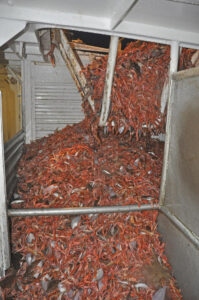
12. Work awaits.

13. The crew make their selections off the catch conveyor.

14. As expected, the darkness haul yielded a smaller return.
Rebecca’s crew threw the ropes off shortly before 5pm as skipper Alan Blackie manoeuvred the 21.5m wooden-hulled twin-rig trawler out of the Eyemouth deepwater basin and down the Canyon before passing under the cliffs at Fort Point.
Clear of the Hurkers, a course was set to take Rebecca northwest past St Abbs Head towards the May Island, some 20 miles away.
Having achieved reasonable prawn fishing from this area the previous night, skipper Alan Blackie decided that a similar approach was justified, so Rebecca was the first local boat to leave Eyemouth on the conveniently timed flood tide.
As Rebecca broke away from the quayside, the crews of around 12 other boats, half of which were visiting trawlers from Amble, Blyth and North Shields, were also preparing to get underway. Although the local summer prawn fishery was probably near its seasonal peak, the comparatively small number of trawlers based at Eyemouth at the time of this trip provided a stark reminder of the extent to which the fleet had downsized in recent years.
Just five years earlier, a procession of up to 40 prawn trawlers would have headed out from Eyemouth harbour in under an hour, before returning in similar close proximity shortly before breakfast time the following morning. Around half of these vessels would have been owned locally, with the balance made up of predominantly under-10m trawlers from northeast England, as far south as Hartlepool.
Decommissioning schemes implemented by the authorities on either side of the England/Scotland border, five miles south of Eyemouth, together with increasing fishing restrictions and rising costs, inevitably resulted in many previously regular boats leaving the fleet for various reasons.
Rebecca steamed past St Abbs headland and across the Kirk Hard into the Firth of Forth on what was turning out to be a fine evening, after heavy afternoon rain had cleared away rapidly – while a quick glance at the radar showed that most other skippers had opted to work the Pelder ground, which starts about one hour out of Eyemouth.
Passing Torness nuclear power station to port and watching the distinctive Bass Rock and May Island profiles come steadily closer on the stem evoked memories of the previous time I had followed a similar course onboard Rebecca, 13 years earlier, when a totally different set of circumstances prevailed.
In March 2001, Rebecca was one of 160 Scottish vessels that took part in a never to be forgotten armada of boats, ranging from under-10m creel boats to 40m deepwater trawlers, which took their case to the heartland of Scotland’s government in a dignified and skilfully co-ordinated protest, sailing 10 abreast under the famous Forth road and railway bridges.
The catalyst for this unparalleled show of solidarity was the sudden decision to close 40,000 square miles of main fishing grounds in the first stage of the EU’s five-year cod recovery programme. Penned into a small area of the North Sea well-known for holding large quantities of juvenile fish, whitefish skippers immediately tied their boats up rather than face the dreaded prospect of slaughtering big hauls of immature haddock, which would represent a large proportion of their catches and therefore income in years to come. Clearly, at the time the EU had not thought about, or attached any importance to, a landing obligation policy.
Shortly after 7pm, by which time Rebecca was less than seven miles east of May Island and 11.5 miles south of Fife Ness, the handle was eased back as the crew quickly shot the twin-rig trawls off the net drum. Unusually for a Scottish twin-rig trawler, the net drum was offset to the starboard side and elevated above the quarter. This location reflected the fact that Rebecca was initially built as a whitefish pair-trawler working large hopper nets – although the arrangement had since proved equally suitable for twin-rig trawls after a middle flange was fitted to the drum.
After 100 fathoms of 18mm-diameter wire had been run off in 31 fathoms of water, Rebecca started to tow the twin-rig gear into the NNW. After being chained up, the wires were towed from a block that ran freely across the trawler’s full beam on a heavy wire mounted between the trawl gallows. Allowing skipper Alan Blackie to use minimal amounts of rudder when compensating for tide drift, this arrangement proved efficient and helped to reduce fuel costs.
Rebecca was towing a set of 160ft twin-rig prawn trawls rigged on 6in and 8in discs supplied by Fraserburgh netmaker Andrew Whyte of Scot Nets. Skipper Alan Blackie used a set of No. 9 Bison trawl doors and 50-fathom sweeps (45 fathoms of 26mm-diameter combination and five fathoms of rubber legs) to spread the gear.
When the gear settled down, the Notus net-monitoring system showed an average door to middle chain clump (750kg) of 165ft, with the middle wire hauled in three fathoms.
Powered by a Caterpillar 3412 engine of 369kW coupled to a Reintjes 6:1 reduction gearbox, installed new in 2007, Rebecca was towing across the tide at 2.6 knots with the propulsion unit running at 1,330rpm.
As the tow continued in an area known as The Rails, the distinctive flashes of Bell Rock lighthouse became steadily brighter directly over the stem. The only other two prawn trawlers in the area were the Buckie trawler Blue Sky, which having left Eyemouth just ahead of Rebecca was towing on a similar course a mile into the east, and the Fraserburgh trawler Shaulora, which was working on the south side of May Island.
Shortly before 11pm, the hydraulics were clutched in as a three-and-a-half-hour tow came to an end.
Once the sweeps and the mouth of the nets had been quickly wound onto the drums, the powerblock was lowered to pick up the port net, before the bag was swung round to the port side. (The preference of Eyemouth skippers to land starboard side to was why Rebecca’s bag-hatch was located on the port side.)
After using the block to dry up the codend before the Gilson rope was clipped in, a fairly healthy-looking port bag was soon being hauled over the side, to reveal almost a three-quarter lift of clean prawns.
When the port bag was run back through the block and flaked on the quarter, the starboard net was hauled in similar fashion to reveal considerably more bulk and a good lift of prawns.
Following a short steam to the desired location for the start of the dark haul, the codends were pushed over the quarter again as the gear was shot away for the second time, before the same length of wires were run out and chained up.
While setting Rebecca on a reciprocal heading to the first tow, skipper Alan Blackie explained that the bigger haul in the starboard net was due to the fact that with the tide on the port side, that net had consistently shown a slightly smaller opening during the haul, and therefore less fishing potential. This difference was further increased by the fact that a number of prawns startled by the herding effect of the port sweep would be swept across the port trawl into the starboard net.
With over 40 boxes of predominately small prawns lying in the reception hopper, the three-man crew settled in for a lengthy stint at the sorting conveyor, in the knowledge that apart from hauling and reshooting the gear again, they would be there until breakfast time. The one good thing was that by landing within eight hours of the first prawns coming aboard, there was no requirement to tail.
Using the selection bins – originally intended for whitefish – arranged inboard of the sorting conveyor and directly above an integrated washer, the crew picked out three sizes of live prawns.
With virtually no by-catch, the clean mud-free prawns were quickly gathered into handfuls and placed into the relevant bins. When the prawns neared the top of a bin, the sliding bottom was pulled out to release the contents into the washer, from where they were emptied into a basket and placed on the deck alongside the fishroom hatch.
By reducing the pile of prawns in the hopper by well over half before it was time to haul again, the system, which eliminated the need for the crew to constantly lift full baskets away from a sorting table and into separate washers, was clearly effective when used by a highly experienced crew.
The second haul of the night was ended shortly before 3am. As expected, although still viable, the return was considerably less than the first haul. Having initially expected to take the dawn tow in the same area, skipper Alan Blackie opted for plan B, which was to steam into the southeast and back across the Kirk Hard, to take the third haul of the night as far into the southwest corner of the Pelder ground as possible.
Although reports from his fellow Eyemouth skippers had not been particularly encouraging, the upside of this move would be to considerably reduce the distance left to steam back to Eyemouth after the final haul was aboard on a Saturday morning.
After an eight-mile shift, the twin-rig trawls disappeared into the darkness a few minutes before 4am, in time for the first light. Having increased the depth of water under Rebecca’s keel to 40 fathoms, Alan Blackie shot 120 fathoms of 18mm wire.
Having fished in relative isolation for most of the night, Rebecca was now joined by a number of other Eyemouth boats, including Ian Craig’s Supreme and David Spouse’s White Heather VI, which together represented half of the larger class of locally owned boats left at Eyemouth – a far cry from the situation just over 20 years ago, when the Berwickshire port was home to nearly 30 whitefish vessels of this class. The lights of several visiting under-10m trawlers could be seen further into the west, towing closer into St Abbs headland.
The hopper was cleared an hour into the last tow, at which point holdman James McQuarter, who had sailed with Alan Blackie for nearly 25 years, reported that 44 boxes of live prawns were stacked in Rebecca’s fishroom, which had a working capacity in excess of 600 boxes.
First light revealed Supreme towing past less than a quarter of a mile off the port side of Rebecca, which by now was towing parallel to White Heather VI on the same heading as Eyemouth, some 10 miles distant.
As anticipated, a shorter third haul came to an end after two and a half hours. When the codlines were untied, around another 10 boxes of a better class of prawn were released onto the floor of the hopper, to bring what had been a fairly reasonable night’s work to a conclusion.
Two hours later – by which time Rebecca was securely berthed in the inner harbour at Eyemouth – the crew hoisted the landing derrick up before swinging their night’s intensive work ashore to DR Collin and Son Ltd for repacking, less than 50 yards from where the catch was landed.
Within six hours, after being washed, regraded, packed and lightly iced in 3kg polystyrene boxes, the prawns landed at breakfast time by Rebecca would be loaded into a refrigerated truck and driven down the motorway network to Folkestone and the Channel Tunnel, for export to Europe. After arriving in France, the pallets of prawns would be transferred onto waiting vehicles, in line with niche market requirements, for delivery to buyers in countries such as Belgium, Germany, France, Holland, Italy and Spain.
Rebecca’s 16-hour trip was just one of the countless trips that local skippers and crews have made from Eyemouth during the summer months in the last 30-plus years. Initially, the inshore prawn fishery was mainly fished by smaller and older boats, some of which had previously seine-netted from the Berwickshire port.
However, change is one of the few constants in the fishing industry, so it is no surprise that patterns continued to evolve. Today, Eyemouth, in common with most other ports in Scotland, ranging from Troon and Campbeltown in the Clyde to Mallaig in the Highlands, Stornoway in the Outer Hebrides and Pittenweem on the East Neuk of Fife, is heavily dependent on Nephrops throughout the year.
Rebecca
The wooden-hulled Rebecca LH 11 was built by Herd & Mackenzie in 1987 as a whitefish pair-trawler for Robert Miller of Musselburgh.
With an LOA of 21.53m and a beam of 6.73m, the stylish Rebecca was a sistership to Bonaventure LH 111, which the same yard delivered a few months earlier to Eyemouth skipper Tom Bain.
Rebecca and Bonaventure were built as a dedicated pair-team to replace the skippers’ previous pair-trawlers. These were Robert Miller’s 66ft Quo Vadis LH 282, built by Thompsons of Buckie in 1975, originally for Wick, and Tom Bain’s Bonaventure LH 11, delivered by Jones of Buckie in 1969 as a seine-netter.
After joining the Eyemouth whitefish fleet in 1987, Rebecca and Bonaventure performed successfully, usually fishing three- to four-day trips before landing locally.
Skipper Alan Blackie bought Rebecca in 1997 as Heatherbelle VI LH 272 from fellow Eyemouth skipper Billy Aitchison.
The purchase of Heatherbelle VI, to which he immediately restored the vessel’s original name of Rebecca LH 11, represented the next step in continual progression for skipper Alan Blackie, who after originally fishing creels from Burnmouth with Mary B, bought his first trawler, the 40ft Jean Howard LN 298, from King’s Lynn in 1983. This was replaced in 1988 with the former 54ft seiner/trawler Franchise LK 378, built by Gerrards of Arbroath in 1969.
The 64ft Jasper II BK 7 was bought from Whitby in 1993 to replace Franchise.
Following the acquisition of Rebecca four years later, Alan Blackie started to pair-trawl with Bonaventure, which had been bought by his brother Brian Blackie.
For the next 10 years, the pair-trawlers continued to follow a successful and well-established pattern of fishing relatively short trips. However, as quotas continued to be reduced to the point where pair-trawling was no longer a viable option, in 2007 the decision was taken to modify the vessels for twin-rig prawn trawling. For the next seven years, this was Rebecca’s main mode of fishing, apart from an occasional few weeks a year single-boat whitefish trawling.
Just three weeks after this trip, Rebecca left Eyemouth, having been a mainstay of the Berwickshire harbour for 27 years, on being bought by the Heather Fishing Co Ltd of Avoch, to pair-seine from Peterhead with the Wee Boy John, at the time when the new sisterships Boy John and Rosebloom were in the pipeline.
When later sold to Campbeltown skipper John Galbraith, Rebecca was renamed Sapphire IV CN 355. On moving to Ardglass last year after being bought by Basil Wills, Sapphire was re-registered N 35.
The move to Ardglass brought Rebecca back into proximity with another former Eyemouth stalwart, Supreme LH 109, which a few years earlier was sold from Berwickshire to Co Down and renamed Pathway B 29.

